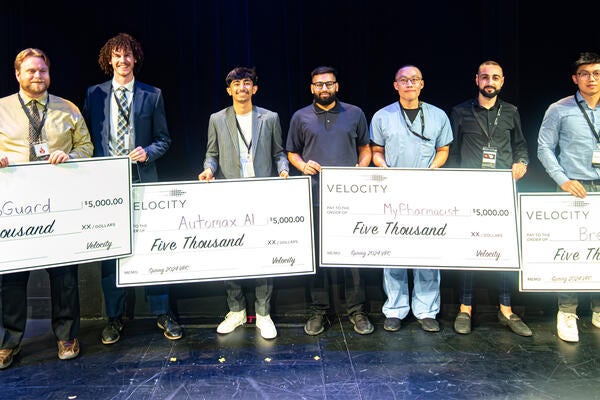
Breakthrough frees tiny, powerful laser device from the lab
Researchers have created a portable version of a tiny, powerful laser device with potential applications in fields ranging from medical imaging to detecting hidden explosives.

Researchers have created a portable version of a tiny, powerful laser device with potential applications in fields ranging from medical imaging to detecting hidden explosives.
By Media RelationsResearchers have created a portable version of a tiny, powerful laser device with potential applications in fields ranging from medical imaging to detecting hidden explosives.
In a project involving the University of Waterloo and the Massachusetts Institute of Technology (MIT), scientists developed a quantum cascade laser capable of operating at temperatures much higher than previously possible.
That means the technology can now be used to generate terahertz radiation outside of the laboratory since it requires only a compact thermoelectric cooler, not bulky cryogenic equipment.
"Many authorities in the field didn't believe these devices could work outside a laboratory environment or anywhere close to room temperature,” said Zbig Wasilewski, a physicist and professor of electrical and computer engineering at Waterloo and a principal investigator at Transformative Quantum Technologies. “Our combined expertise just changed this paradigm."
Portability paves the way for the device to have an impact via terahertz imaging and spectroscopic systems in areas including medicine, communications, quality control, security and biochemistry. Until now, the generation of terahertz radiation powerful enough to perform real-time imaging and fast spectral measurements required temperatures of less than -100 degrees Celsius. The new terahertz quantum cascade laser, detailed in a paper published today in the journal Nature Photonics, can function at temperatures of up to -23 degrees Celsius.
“With a high operating temperature, we can finally put this in a compact portable system and take this breakthrough technology out of the laboratory,” said Qing Hu, an MIT professor who has been researching photonic terahertz device physics since 1991.
Terahertz quantum cascade lasers measure only a few millimetres in length and are thinner than a human hair. They generate electromagnetic radiation in the spectral range between microwaves and mid-infrared.
“This opens up the road to further advancements and provides a significant boost of confidence for my graduate students as we pursue complementary terahertz research,” said Wasilewski, the University of Waterloo Endowed Chair in Nanotechnology.
An immediate potential application of the portable system, which includes a compact camera and a detector, could be to provide imaging for skin cancer screening or during surgical procedures.
It could also be deployed in industries where the detection of foreign objects in products is required for safety and quality assurance, and for sophisticated detection of gases, drugs and explosives.
This work is supported by the National Aeronautics and Space Administration (NASA), the Canada First Research Excellence Fund (CFREF) and the Natural Sciences and Engineering Research Council of Canada (NSERC).

Read more
Velocity pitch competition winners share exciting startup ideas using artificial intelligence and deep tech, showcasing creativity and entrepreneurial prowess

(Getty Images/Meggj)
Read more
Study examined effect of rising temperatures on California’s crop

Read more
Distinguished Waterloo historian and Holocaust expert helps correct the total death toll on an English Channel Island
The University of Waterloo acknowledges that much of our work takes place on the traditional territory of the Neutral, Anishinaabeg, and Haudenosaunee peoples. Our main campus is situated on the Haldimand Tract, the land granted to the Six Nations that includes six miles on each side of the Grand River. Our active work toward reconciliation takes place across our campuses through research, learning, teaching, and community building, and is co-ordinated within the Office of Indigenous Relations.